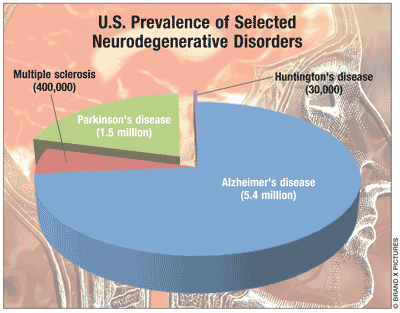US Pharm. 2012;37(1):6.
The mission of the National Institute of Neurological Disorders and Stroke is to reduce the burden of neurologic disorders by translating basic scientific advances into treatment and prevention protocols. For many neurodegenerative disorders, health risks increase in the aging population, posing social and economic challenges. Developing treatments that slow neurodegeneration is the goal of the National Institute on Aging.

Alzheimer’s Disease (AD): In most people with AD, symptoms first appear after age 60 years. The time from diagnosis to death varies from as little as about 4 years in persons aged >80 years at diagnosis to >10 years in younger individuals. Experts estimate that, in 2030, 72 million people will have AD if the trend of doubling every 5 years beyond age 65 years continues. In 2007, AD was the second most common diagnosis (11.2%) in patients being admitted to hospice care, preceded only by cancer (42.9%). According to the CDC, 3.8% of all hospice discharges are for AD, while AD affects 15.5% of nursing home residents. AD is the sixth leading cause of death in individuals aged >65 years.
Parkinson’s Disease (PD): PD affects 1.5 million people, with 60,000 newly diagnosed each year; men and women are equally afflicted. Although PD usually develops after age 65 years, 15% of diagnosed patients are aged <50 years. After AD, PD is the most common neurodegenerative disease. Current treatments improve symptoms but do not slow the underlying loss of brain cells, and most people with PD progress to severe disability over 10 to 20 years.
Multiple Sclerosis (MS): About 400,000 people have MS, which disproportionately affects the white population and women; women are three times more likely to develop the disorder. MS is usually diagnosed in young adults, and initial symptoms are typically experienced between age 20 and 40 years. Eighty-five percent of patients have relapsing-remitting MS; the rest have primary progressive MS. MS prevalence varies from 58 to 95 per 100,000 population.
Huntington’s Disease (HD): About 30,000 people have HD, with a prevalence of 1 in every 10,000 people. General lifespan is 15 to 25 years after onset of HD. In 67% of cases, HD is passed from parent to child through a mutation of the HD gene located on chromosome 4. Since only one parent must have a genetic defect for a child to inherit HD, at least 150,000 people are estimated to have a 50% risk of developing HD, and thousands more of their relatives live with the possibility of developing HD.
To comment on this article, contact rdavidson@uspharmacist.com.





